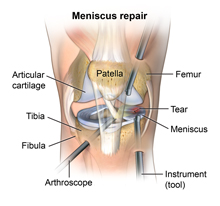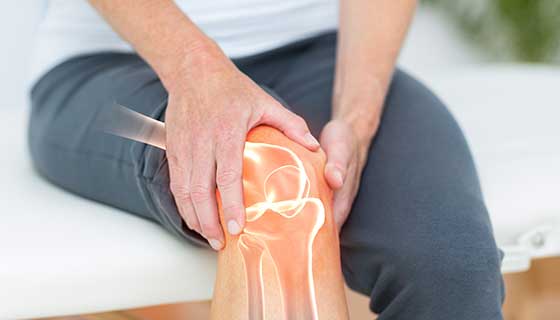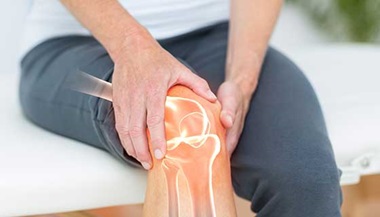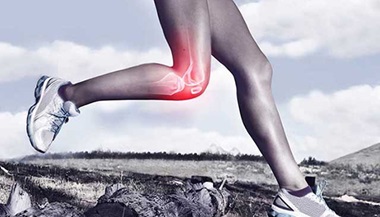Torn Meniscus
What You Need to Know
- The meniscus is a c-shaped pad of cartilage in the knee that acts as a shock absorber.
- Each knee has two menisci.
- Meniscus tears are common knee injuries.
- Knee arthroscopy is often used to treat meniscal tears.
What is a meniscus tear?
The menisci sit between the tibia (lower leg bone) and the femur (thigh bone) and protect the lower part of the leg from the shock created by our body weight. The medial meniscus sits on the inside of the knee and the lateral meniscus sits on the outside of the knee.
Meniscus tears usually take place when an athlete twists or turns their upper leg while their foot is planted and their knee is bent.
Occasionally menisci can develop as a block or disk shape, which is called a discoid meniscus. A discoid meniscus is more likely to tear and commonly presents in childhood.

What are the symptoms of a meniscus tear?
Symptoms of a meniscus tear may be different for each person, but some of the most common symptoms are:
-
Pain in the knee joint: usually on the inside (medial), outside (lateral) or back of the knee
-
Swelling
-
Catching or locking of the knee joint
-
Inability to fully extend or bend the knee joint
-
Limping
The symptoms of a meniscus tear are similar to other medical conditions or problems. Always see your health care provider for a diagnosis.
Meniscus Tear| Grace's Story
How is a meniscus tear diagnosed?
If a meniscal tear is suspected, your orthopedist will conduct a thorough health history and evaluation of the knee and may also order X-rays and magnetic resonance imaging (MRI) to confirm the diagnosis and further evaluate the knee joint:
X-ray
An X-ray is a diagnostic test that uses invisible electromagnetic energy beams to produce images of internal tissues, bones, and organs onto film. When a standard X-ray is not accurate enough, a joint X-ray with contrast dye may also be used to examine joints such as the knee or hip.
MRI
An MRI is a diagnostic procedure that uses a combination of large magnets, radiofrequencies, and a computer to produce detailed images of organs and structures within the body; can often determine damage or disease in a surrounding ligament or muscle.
Meniscus Injuries | Q&A with Dr. Andrew Cosgarea
Pain or a catching feeling in the knee—could it be a meniscus tear? Andrew Cosgarea, M.D., chief of the division of sports medicine at Johns Hopkins Orthopaedics, answers common questions about meniscus injuries.
Treatment for a meniscus tear
Specific treatment for a meniscus tear will be determined by your doctor based on:
-
Your age
-
Your overall health and medical history
-
How bad your injury is
-
How well you can tolerate specific medications, procedures, and therapies
-
The length of time it will take to heal
-
Your opinion or preference
Treatment may include:
-
Icing
-
Medication, such as ibuprofen
-
Muscle-strengthening exercises
-
Arthroscopic surgery

Arthroscopy
Knee arthroscopy, a minimally invasive procedure, is often used to treat meniscal tears. During an arthroscopy, a small, lighted, optic tube (arthroscope) is inserted through a small incision in the joint. Images of the inside of the knee are then projected on a screen allowing the provider to repair or trim out the torn portion of the meniscus. For young patients, preserving as much of the meniscus as possible is important to preserving knee health.
When the meniscus is repaired, sutures are used to hold the meniscus together while the body heals the site. Pediatric meniscal tears treated with arthroscopy tend to heal better than those managed with other treatment options.
Knee Replacement Surgery | Q&A with Savya Thakkar, M.D.
An expert in hip and knee replacement surgery, Savya Thakkar discusses common reasons for knee replacement, the procedure, the types of implants and recovery.









